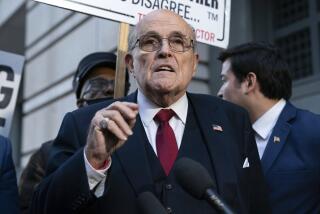Symington Lied, Abused Office, Prosecution Charges
- Share via
PHOENIX — Arizona Gov. Fife Symington lied to lenders and “abused his office” by trying to extort loan concessions in an attempt to shore up his crumbling real estate empire, a prosecutor charged Friday at the start of the governor’s trial on fraud, extortion and perjury charges.
Symington’s lead attorney, however, told the jury that the governor is “completely innocent of the charges” and blamed Arizona’s real estate depression for his client’s undoing.
In his opening statement, Assistant U.S. Atty. David Schindler asserted that the former high-flying developer tailored his financial statements depending on whether he wanted to borrow money or win release from previous commitments.
Symington’s alleged misrepresentations were part of an effort to keep his office buildings and shopping centers afloat by creating the impression that he was a successful developer worth millions, Schindler said.
“You’ll see he is a very smart and clever man who told lies to get millions of dollars in loans and then schemed to cover up those lies,” Schindler told the U.S. District Court jury. “When he wanted to get out of loans, he told a different story.”
Symington, who is bankrupt, would be forced to resign if convicted of any of the 22 charges filed against him after a seven-year investigation by the U.S. attorney’s office in Los Angeles.
The 51-year-old conservative Republican, who campaigned on the premise that it was time the Arizona economy was run like his own businesses, has said he looks forward to exoneration and plans to seek a third term in office in 1998.
On Friday, however, Symington listened grim-faced from the defense table as Schindler said that between 1986 and 1991, the developer prepared numerous sets of false personal statements--bearing the same “as of” dates but reporting different net worths--for various lenders.
Even after his election in February 1991, Schindler said, Symington continued to misrepresent his assets to negotiate favorable settlements of outstanding loans, win release from millions of dollars in loan guarantees--and cover up previous false statements.
Schindler said Symington allegedly supplied false material to avoid being declared in default for failing to maintain a net worth of $4 million--a condition of two loan packages totaling $77 million and $50 million respectively for a project that included two office towers and a Ritz-Carlton Hotel.
He also accused Symington of fabricating three versions of his financial condition as of Dec. 31, 1989. One, submitted to a bank from which he needed money, showed a net worth of $5.3 million. Another, supplied to a bank from which he sought loan concessions, showed he was $4.1 million in the hole. A third submission said he had not prepared a statement for that period.
In what the prosecution called an extortion attempt on six labor pension funds that had loaned him $10 million in 1990, Symington allegedly threatened to use his powers as governor to void the primary lease agreement at his failing downtown Phoenix commercial center, called the Mercado--a move that would have severely damaged the pension funds’ investment.
According to the prosecution, Symington threatened to do this unless he was given a release from his personal guarantee of the loan and a pledge from the pension funds not to file a notice of default and begin foreclosure on the mixed-use retail and office center that once stood at the heart of his real estate ventures.
*
When Symington received that loan, he signed a financial statement swearing that he had a net worth of $11.9 million. A year later, when he wanted to renegotiate the terms of the loan, he gave another financial statement showing he was $23 million in the red, according to court documents.
The Mercado was among two dozen properties that Symington watched plunge in value when the real estate market nose-dived in the early ‘90s.
Facing a court order to repay the pension funds loan, Symington filed for Chapter 7 personal bankruptcy in late 1995, citing debts of nearly $25 million and assets of $61,795.
In his opening remarks, Symington’s lawyer, John Dowd, maintained that while some of the governor’s financial statements contained “estimates from memory,” auditor mistakes and unintentional errors and omissions, lenders did not rely on the questionable information to make a decision when they gave him millions of dollars in development loans. As a result, he seemed to argue, there was no harm and no foul.
“The bankers loaned money to him on his reputation and performance as a developer,” Dowd said. “He never received money he was not entitled to.”
The trial, which is expected to last about 12 weeks, has become another embarrassing spectacle in this state’s political scene.
In 1988, Gov. Evan Mecham was impeached for diverting inaugural ball donations into a loan for his sinking automobile dealership. In 1991, seven Arizona legislators were indicted for bribery. Then came the Keating Five, a group of federal lawmakers with personal ties to savings-and-loan swindler Charles E. Keating Jr.
Now comes Symington, the flaxen-haired, Harvard-educated scion of fortunes whose personal financial records are being used against him in court.
Symington has met with Arizona Secretary of State Jane Hull to discuss passing her the baton of power if he is unable to complete his term.
Sensing vulnerability, numerous Republicans and Democrats have already signaled a desire to enter the 1998 gubernatorial race.
“Politically, Symington is on life support whether he is found innocent or guilty in a court of law,” said Melodee Jackson, executive director of the Democratic Party in Arizona, which has made the 1998 election its top priority. “Incredibly, Fife seems not the least embarrassed by any of it--if moxie were money he wouldn’t be bankrupt.”
Bruce Merrill, a political pollster and professor of political science at Arizona State University, attributed Symington’s survival thus far to “a bulldog bunker mentality, shrewd political operatives and great spin doctors.
“When our poll showed that 47% of the electorate wanted him to resign immediately, and 52% wanted him to stay in office or had no opinion, what did Symington do?” Merrill asked. “He called a news conference to say, ‘Look, here’s a poll showing that a majority of voters don’t want me to resign.’
“I think the spin on this trial, if he’s exonerated, is going to be this: Here is a man who had the guts to take on the federal government and kick its butt,” he said. “He’ll have a whole new political career.”
More to Read
Get the L.A. Times Politics newsletter
Deeply reported insights into legislation, politics and policy from Sacramento, Washington and beyond. In your inbox three times per week.
You may occasionally receive promotional content from the Los Angeles Times.











